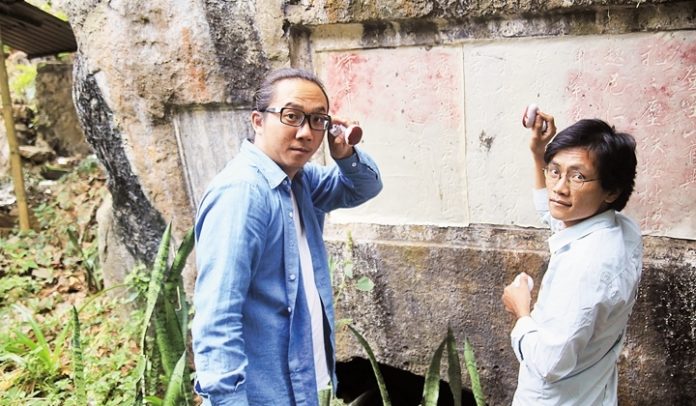Thinking about history in different way
When Tran Quang Duc has released the Ngan nam ao mu book, even the publishing house side has thought that it is difficult to sell. However, the first 1,000 copies of the 398-page hardcover edition were sold out in the first two weeks after their release. The book is currently continuing to be sold; the book has even appeared on Wikipedia. The book has been described as the most comprehensive research ever undertaken on the subject, and Tran Quang Duc has become known as an expert on researching traditional costumes. Meanwhile, his friend, Nguyen Huu Su, will release his book named Lich su thu phap in 2017.
The authors, Tran Quang Duc and Nguyen Huu Su, are contributing to break down stereotypes through their works. According to researcher Duc, ao dai (long dress) and khan xep (ready-to-wear turban) are considered as the archetypal traditional Vietnamese costumes; however, during the Le Dynasty, Vietnam had ao giao linh (cross-collared robe) and people cut their hair short.
Meanwhile, Su’s the first book will systematise notions of calligraphy. Sharing his opinion, Su said that this is not as simple as writing letters on paper. Calligraphy is a visual art related to writing. “It is an art which centred on writing and painting boundaries, a way of getting insight into the writer’s psychology and personality,” he added. The 250-page book will help readers to better understand the art of calligraphy over the centuries, which is not only only a Chinese art, Su affirmed. The Republic of Korea (ROK), Japan and Vietnam also have an excellent artistic base. The book will not revolve around the ong do (“calligrapher”)’s writing nice words in calligraphy at the Temple of Literature in Hanoi or calligraphy work used as decorations for the Tet holiday. Nguyen Huu Su’s book will focus on the main categories of traditional calligraphy, such as the A di da Phat (Amitabha Buddha) stele of the Ly Dynasty—a typical work of the k’ai, or kai, style, or Lenh cam chi tren nui Duc Thuy (A Ban by King Tran Hien Tong on Duc Thuy Mountain) in Tran Dynasty—typical work of the hsing, or xing, style, or the best calligrapher such as Le Hien Tong, Nguyen Phuc Chu, Vu Tuan and Nguyen Can. Among works using the Han script (Chinese characters), Vietnamese calligraphy also uses the Nom script, which is a logographic writing system formerly used to write the Vietnamese language, as in Trinh Sam Lord’s works. Nguyen Huu Su said that he standardised his opinions, which were referenced by many calligraphy professionals.
Acting for believing
Writing a book is still venturesome when a reading culture has only just emerged. For this reason, Tran Quang Duc was not sure that his next books would sell as well as Ngan nam ao mu. However, the results of its release are a driving force for Duc’s next book project. “The researching period is also myself-awareness changing period. My opinions were changed when I approached the domestic and foreign scholars’ perspectives. Meanwhile, Nguyen Huu Su has also spent much time finding estampages and documents.
However, researcher Phan Cam Thuong said that, “The traditional culture has been being restored.”. A generation of young people have been educated on Han-Nom and Oriental culture at the Faculty of Han-Nom, former Hanoi General University, or specialise in China, such as Tran Trong Duong, Tran Quang Duc and Nguyen Huu Su. They have been also supported by search engines on the Internet, such as Google and Baidu.
After all, it is necessary to have a belief. Understanding our forefathers’ source will help future generations recognise Vietnam’s values, correct preconceptions and liberate their thinking.
|
Tran Quang Duc, born in 1985, is a freelance researcher. He has been presented the first prize in the Chinese Bridge Language Competition in 2004. He graduated from Peking University in China. He has translated works including The Classic of Tea, Chang'an Turmoil and Records of the Grand Historian, while he has written Ngan nam ao mu (A Thousand Years of Caps and Robes). Nguyen Huu Su, born in 1986, graduated from China’s Fujian Normal University’s Philological Faculty. He is working at the Department of Buddhist Studies, Institute for Religious Studies at the Vietnam Academy of Social Sciences. He participated in publishing Han-Nom Heritage at the Communal House in Chem Village in 2015. He is preparing to publish Lich su thu Phap (“History of Calligraphy”) in 2017. |




